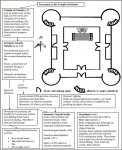I've had a related problem that I've pondered a solution for.
I would love an application (the kind of thing I make for a living) that would streamline the building of an adventure AND the running of it at the game table.
What I've found is NOT what I am looking for is a Word document with all the rooms numbered and description text with monster stat blocks.
Nor is it an Initiative/combat tracker matrix tool.
I envision an interface with tabs perhaps for NPCs, Places, Items, Monsters, TimeLine. I might click on Places and create a Dungeon with a map attached. Then I right-click on the area with Room 1 and choose "New Room" and fill in the flavor text and contents. I might choose or randomly roll a CR2 monster and drop that in, which also links in on the Monsters tab. The monster's gear and random loot get rolled up and will appear on the Items tab as well as on the Monster itself when I look at it directly or from the Place tab when I view Room 1.
Each Item will have a checkbox that denotes if the players have taken it. that means I can flip to the Items tab, set it to show "only taken items" and deliver a list of all the loot to the players easily.
I don't know if this is the most expediant way to design the adventure or run it, but some kind of Gaming-centric easy entry and navigating tool would make GMing a lot easier.
I might use the TimeLine to define the major point of the adventure. Each NPC has a connection to this TimeLine to reflect WHERE they are. So in the Beginning node of the TimeLine, the Mayor is at his House. In the Climax node, he's in the secret evil lair. In this way, I just set where we are in the TimeLine, and the NPCs update to their correct position. Useful for things that run on a script. Might have some issues where things have changed, but no worse than me fumbling around trying to find the Mayor's stats who was listed in Chapter 1 of the PDF, and I need him for Chapter 12 at the Evil Lair. I this way, I'd just set our TimeLine to Climax, and then look at the Evil Lair on the Places tab and the Mayor would be there, ready to be a BBEG.




